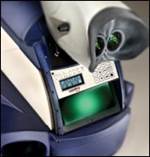Controlled Metal Build Up Process for Generation, Modification and Repair of Molds and Dies
The controlled metal build up (CMB) process—a technology developed at the Fraunhofer Institute for Production Technology IPT (Aachen, Germany).
|
The controlled metal build up (CMB) process—a technology developed at the Fraunhofer Institute for Production Technology IPT (Aachen, Germany)—combines laser deposition welding with milling in a high speed cutting (HSC) machine in order to build up, modify and repair molds and dies. The process originated from rapid tooling concepts where the generation of parts is done layer by layer. The process works with all weldable materials, including tool steels, notes Elke Fuchs, a Diplomated Engineer at the institute (which is comparable to a Master of Engineering in the United States). “We reach full density and hardness values with a maximum of 60 HRC—depending on the material,” Fuchs explains. “The values for surface roughness obtain 0.4 to 3µm Ra without any post-processing.” The welding device consists of a material feeder and a laser source mounted beside the spindle of the three-axis, portal-type milling machine tool. When milling, the welding device is moved upward by a pneumatic mechanism to prevent it from damage and avoid collisions with the workpiece. The use of an HSC milling machine tool guarantees high-precision machining and the removal of damaged areas, build-up and finish machining in one clamping position, Fuchs notes. Fuchs adds that the methods of welding and milling can be used intermittently while being integrated in a machine. “Each layer of the weld metal is machined in plane surface in order to generate a defined surface for the next layer,” explains Fuchs. “Depending on its desired shape, the outline is in the end processed triaxially or also alternately. If this is the case layer after each layer, only very short protrusion lengths of the tools are necessary.” Even deep slits can be contoured using small tools, which can eliminate EDM operations, according to Fuchs. NC programming of the needed welding and milling path is done fully automatically by slicing the CAD model by an additional program tool. This speeds up the data generation significantly, Fuchs says. In addition, implementing CMB technology on the shop floor improves the reduction of material and time consuming operations. Simultaneously, the required surface quality and dimensional accuracy without additional downstream finishing processes are achieved. “In the future, we will aim for further process optimization, and upgrade to a five-axis process to enable the fabrication of undercuts and further execution in industrial practice,” Fuchs states. |
Related Content
-
The Secrets to Hard Milling Success
The Secrets to Hard Milling Success
-
How to Use Thermal Management to Improve Mold Cooling
A review of common mold cooling issues and possible solutions, including 3D printing applications.
-
What is Scientific Maintenance? Part 2
Part two of this three-part series explains specific data that toolrooms must collect, analyze and use to truly advance to a scientific maintenance culture where you can measure real data and drive decisions.






.jpg;maxWidth=300;quality=90)





